This was published 3 years ago
‘I really very much enjoyed being Sharon Stone. But I’m enjoying being myself more’
One of the last of the Old Hollywood divas, the actor comes clean on the story behind the scene that made her famous - and plenty more.
By Jane Cadzow

In her new memoir, Sharon Stone (pictured here in Berlin in 2019) reveals extraordinary details of her traumatic childhood: “We all, in our family, had kept secrets of shame and terror.”Credit: Getty Images
Sharon Stone is running late. It’s Friday afternoon in Los Angeles, where the actor lives, and Saturday morning in Canberra, where I’m staring hopefully at my computer screen, waiting for our video call to begin. Stone has written a book, a humdinger of a memoir in which she reflects on
everything from her battle for custody of her oldest son to her recovery from a near-fatal brain haemorrhage. She reminisces about her reign as Hollywood’s favourite femme fatale, ruminates on sexual harassment in the film industry and makes a horrifying revelation about her childhood. All in all, there’s a lot to discuss in the three-quarters of an hour allotted for the call.
At 10.36am, six minutes past the scheduled start time, a smiling face appears on my screen. It’s a member of Stone’s publicity team. “We’re just trying to get in touch with Sharon,” she says in a bright tone. “She should be on in
the next few minutes.”
Uh-oh. Trying to get in touch with Sharon? What does that mean? They can’t find her? I suspect that if Stone were in my position, she’d let fly with some choice expletives. From what I know – and I’ve done quite a bit of research in
the weeks it’s taken to set up this interview – she’s a woman you mess with at your peril. Joe Eszterhas, who wrote the script for her smash hit 1992 movie Basic Instinct, claims she waved a gun at the film’s cinematographer, saying, “If I see one ounce of cellulite on-screen, you’re a dead motherf…er.” (Stone denies she brandished a weapon but has conceded she may have lightheartedly threatened to kill the guy.)
Anyway, look, I’m sure everything will be fine. I take a deep breath. I reread my list of questions. At 10.42am, the publicist returns. “I’m so sorry,” she says. “I’m still waiting for Sharon to join.”
I get the impression that punctuality has never been Stone’s strong suit. British actor Rupert Everett recounts in his own fabulously indiscreet memoir, Red Carpets and Other Banana Skins, that when he co-starred with
Stone in the 2004 film A Different Loyalty, she routinely kept cast and crew cooling their heels for extended periods while she lingered in her trailer. When eventually she swept onto the set, followed by a retinue of attendants, she offered no explanation for the delay and no one dared ask. “Her blue eyes danced dangerously under arched eyebrows,” Everett writes. “Everyone got up as she came in, putting down their magazines and coffee.”
The publicist is back again, sounding relieved. “Okay,” she says. “I finally have an update. She’ll be on in five minutes.” Whew. I sit straighter in my chair. I neaten the papers on my desk. I wait.
Stone was late for the distinguished American photographer Richard Avedon, who took her picture for The New Yorker in 1996, the year she was nominated for an Oscar for her inspired performance in Casino. John Lahr, who profiled her for the magazine, described Avedon pacing the corridor in his studio,
anxiously awaiting her arrival. His concern contrasted with Stone’s breezy good humour when at long last, clad in a mink coat, she sashayed through the door.
According to Lahr, Avedon did not warm to Stone, concluding that, despite her chattiness, she had little genuine interest in other people. “She’s interested in the effect she has on you,” the photographer said. “When she thinks she sees her reflection in my eyes, and I respond, she’s satisfied and changes the subject.”
You don’t get leading roles in movies unless the camera loves you. But Stone is something else again: a great beauty.
Another 10 minutes have ticked away. At this rate, I’ll barely have a chance to introduce myself before Stone is hustled off to her next appointment. I wish we were going to be in the same room, rather than talking via Zoom. I gather that, up close, her volatile temperament is a wonder to behold. Journalist Sean Smith once wrote in Newsweek that “seated on a couch next to Stone, you feel as if she could laugh, cry, scream, kiss you or slap you at any moment. It’s exciting, but you’re tense as a cat every second.”
More time passes. My mind wanders to the bit in Red Carpets where Everett says he came to realise that Stone was the kind of actor who never stopped performing. From the moment she opened her eyes in the morning, she was on: “The world was her camera and her alarm clock was the clapperboard.” Steven Soderbergh, who directed her in the recent TV miniseries Mosaic, admitted to Town & Country magazine to being somewhat in awe: “In my phone,” he said, “I have her as ‘Sharon F…ing Stone’.”
Hang on. There’s movement on my screen. It’s SFS herself. Lights. Camera. Action!
Film stars are almost by definition uncommonly attractive people. You don’t get leading roles in movies unless the camera loves you. But Stone is something else again: a great beauty. The planes and angles of her face are so aesthetically pleasing, her features so perfectly proportioned and aligned, that I find myself momentarily distracted from the task at hand. It occurs to me that the genetic miracle that produced this visage may also have made
her immune to ageing. At 63, she looks much the way she’s always looked, with sharper cheekbones.
“I’ve been Zoom-Zoom-Zoom-Zooming!” she tells me in the slightly raspy voice that reportedly prompted Basic Instinct director Paul Verhoeven to observe, “If an ashtray could talk, it would sound like Sharon Stone.”
What she means is that she’s been doing other interviews about her memoir. They went longer than planned, she explains cheerfully. Entirely her fault. She talked too much. “So I apologise. It’s been a Zoom-arama!” I beam back at her, instantly disarmed. Somewhere in my head is a quote attributed to the late producer Robert Evans, who fell out with Stone during the making of the 1993 film Sliver.
“Charm? Like a barracuda,” Evans said bitterly. The literature about Stone is littered with examples of men who’ve limped away from encounters with her feeling much the worse for wear. I am not going to hold this against her.
Sharon Stone is the greatest American sex symbol since Marilyn Monroe, in the opinion of Joe Eszterhas. I prefer to think of her as the last of the larger-than-life screen sirens. Though she first became famous in the 1990s, she embodies a type of Old Hollywood glamour and her conversation
crackles with lines that could have been lifted from the black-and-white movies she watched while growing up in the backwoods of Pennsylvania.
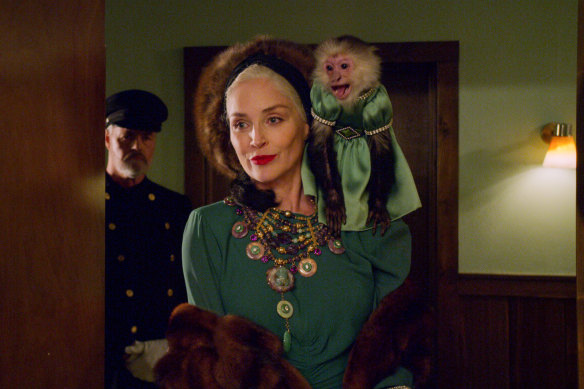
In the 2020 series Ratched. One director notes that she’s not only able to cry on command, but produce a tear in one eye only.Credit: Courtesy of Netflix
In her book, The Beauty of Living Twice (Allen & Unwin), she refers to women as “broads” and “dames”. In my copy, I have underlined the sentence: “Where I came from, guys with guns handled things.” And: “I asked Dr Handsome, ‘Will I lose my ability to speak?’ ” After director Martin Scorsese cast her in Casino, he said: “It’s as if I’d met Joan Crawford.”
Today she is wearing a silky leopard-print jacket with a plunging neckline, and lounging on what looks like a mound of white fur. Behind her, a gilt-framed mirror hangs on a grey panelled wall. Her house stands on a block of land in Beverly Hills formerly owned by Mary Pickford, superstar of the silent-film era. The ersatz chateau, home to Stone and her three sons – Roan, 20, Laird, 15, and Quinn, 14 – was under construction when she bought the
property 28 years ago. Architectural Digest reports that she imported antique floors from India and Switzerland, and engaged a chateau restorer – there’s a niche occupation – to “give the place texture and a sense of history”.
“I can be quite imperious. “I will say to people, ‘Don’t talk to me like that!’ ”
I half-expect a cook or gardener to wander into view while we’re talking. In the book, there are enough passing mentions of the hired help – housekeepers, bodyguards, personal assistants and so on – to make clear that looking after Stone is a small industry. Lahr wrote in The New Yorker that her staff referred to her among themselves as “the diva”. Their name for the house was Divadom.
“I can be quite imperious,” she volunteers before I get around to raising the subject. She supposes this is partly a side-effect of stardom: all that adoration from the fans can lead to the expectation of a degree of deference from everyone around you. Those who are over-familiar, or insufficiently respectful, feel her wrath. “I will say to people, ‘Don’t talk to me like that!’ ” She has a hunch she’d have had a certain hauteur whichever way her life panned out. “I think I was like that when I was three or four. It’s part of my personality.”
Her take-no-prisoners approach to the opposite sex seems always to have been there, too. Stone writes that when she was in first grade, one of the boys grabbed her and kissed her in a dark stairwell, then ran off. After regaining her composure, she strode outside to the playground and fixed him with a stare. “I stalked up to him. He was frozen. I grabbed his arm and bit him as hard as I could and walked away.”
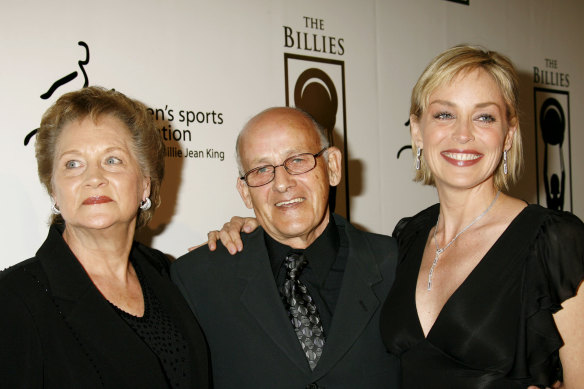
With mother Dorothy and father Joe. Until Stone was 14, Joe thrashed her with a strap frequently.Credit: Australscope
Born in 1958 in the small Pennsylvanian town of Meadville, Stone was the second of four children in a family she paints as gothically dysfunctional. Her father, Joe, worked shifts in a tool-making factory. He hunted for food to put on the table (mounted animal heads adorned the walls) and, at frequent intervals, doled out beatings to Stone and her siblings. The way Stone tells it, Joe needed only the slightest provocation to drag her to the basement and thrash her with a strap. Her mother, Dorothy, had been removed from her own parents because her father, Clarence, beat her with a savagery that, as Stone puts it, was unacceptable “even in hillbilly country”. At the age of nine, Dorothy was placed with a dentist’s family and worked for them as a maid.
One night when Stone was 14, she decided she’d had enough of Joe’s beltings. She writes that when he summoned her to the basement, she looked him coldly in the eye and said, “What’s the matter – do you need to hit me some more to feel like a man?” Her father started to cry, she says, and never again laid a hand on her. (They later became close.)
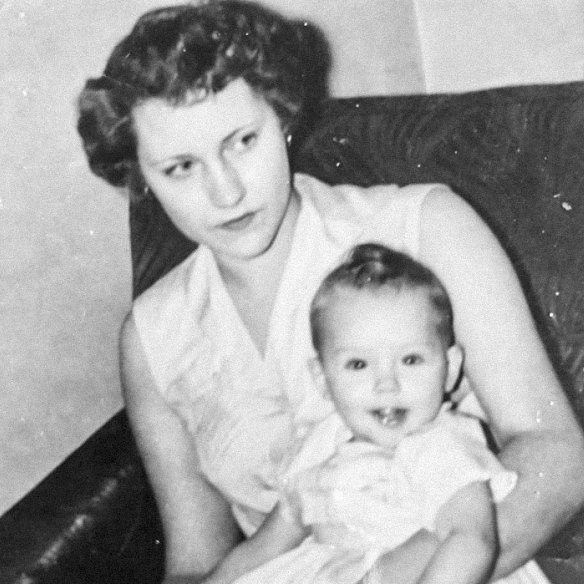
Stone as a toddler with her mother in 1960.Credit: @sharonstone/Instagram
Stone was academically gifted – she started university studies while still at school – but her most urgent ambition was to get the hell out of Meadville. At 19, she moved to New York to work as a model. Three years later, in 1980, she
headed for California and a career in the movies. Over the next decade, she appeared in a string of forgettable films: Deadly Blessing, The Vegas Strip War, Police Academy 4, Action Jackson and many more.
In the book Bad Movies We Love, Edward Margulies and Stephen Rebello devote a whole chapter to Stone’s early oeuvre (she sportingly wrote the foreword). For most of 1985, she was in Zimbabwe making King Solomon’s Mines and Allan Quatermain and the Lost City of Gold, later summing up her contribution to these back-to-back bombs as “a bad hairdo running through the jungle”.
Stone waxes lyrical about the camaraderie of movie-making. “There is so much love on location,” she writes. Yet it is rumoured she created so much animosity during the African shoots that, before she did a bathing scene, crew members urinated into the water. When I ask gingerly about her reputation for being difficult, she insists that all she does is stand up for herself.
Take the time she was required to fire a blank cartridge from close range at a plexiglass plate placed in front of a camera. “You’re supposed to put a quarter-load of this wadded paper in the gun because a full load killed somebody on a set,” she says. But while her back was turned, the quarter-load was replaced with a full load – “because they wanted a burst of flame coming out of the gun”.
“I grabbed the producer by the lapels, picked him up and went to punch him in the face.”
When she pulled the trigger, the burning wad ricocheted off the plexiglass and hit her in the face, singeing her eyebrow. “It could have put my eye out,” she says. Her response? “I grabbed the producer by the lapels, picked him up and went to punch him in the face. I said, ‘You motherf…er, you could have killed me. You’re a f…ing idiot! You broke the law, you f…ing idiot.’ ”
It crosses my mind that my son, in the next room, may be wondering what I’ve done to annoy Sharon Stone. “You killed actors doing this!” she shouts. “You motherf…er. I’m going home.” She pauses, then addresses me in a normal voice: “These are the things that make me ‘difficult’.”
In Basic Instinct, the film that changed her life, Stone played Catherine Tramell, a coolly seductive bisexual novelist with an unfortunate habit of killing men with an ice pick. Stone was not the first choice for the role: a dozen better-known actors had knocked it back because of the graphic sex and violence. In the most famous scene, Tramell uncrosses her legs while
being questioned at a police station, giving her interlocutors – and cinema audiences – a view up her skirt. She is wearing no underwear. The hapless cops break out in a sweat.
The “vagina shot”, as Stone calls it, wasn’t in the script. In an interview filmed soon after the movie’s release, she claims credit for Tramell’s bold gesture: “It was really my idea that she would do that … She’s telling these people in the room: I have absolute power over you.”
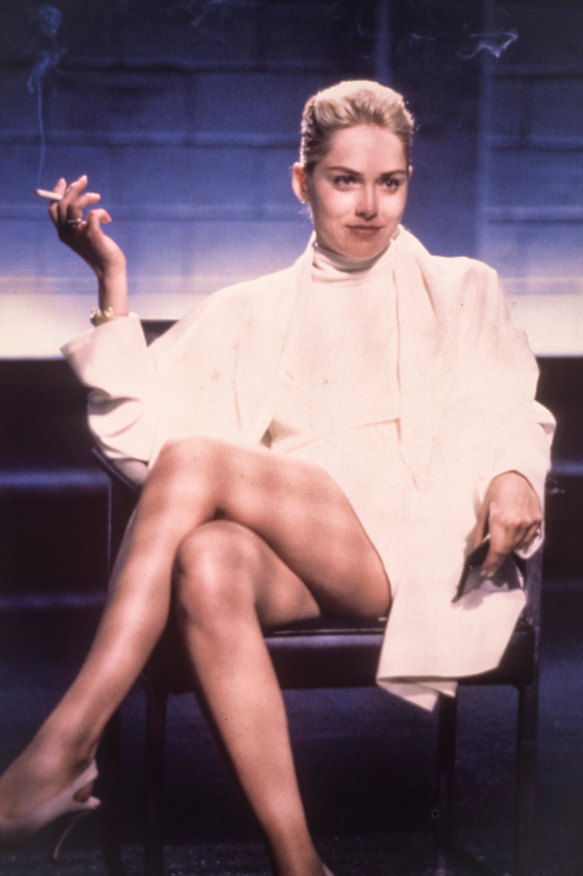
Stone says she was tricked into the infamous “flashing” scene in the 1992 movie Basic Instinct.Credit: Alamy
Stone maintains that though she wanted the scene to convey that the detectives were getting an eyeful of her pantie-less crotch, she didn’t intend for the whole world to see it. She says Verhoeven tricked her, telling her she needed to remove her white knickers only because they were reflecting the light. The director, for his part, has always insisted that Stone knew exactly what she was doing and that, immediately after filming the scene, he played it to her on a monitor.
In the book, Stone says the first time she saw the up-the-skirt shot was at a preview screening of the film. “They showed it to me in a room full of strangers,” she tells me. “It was humiliating and upsetting.” She says she went to the projection booth and slapped Verhoeven across the face. She asked him to cut the shot; he refused, and ultimately she came to agree with him that it was right for the film.
Basic Instinct was a global sensation. Everybody lined up for tickets. Britain’s The Independent newspaper has declared it a trash masterpiece – “deliriously
inventive, hatefully incorrect and exhilaratingly sure of its bad taste”. At the time, Stone told journalists that filming the brutal murders was so traumatic she had a paramedic standing by with an oxygen mask in case she passed out.
Eszterhas scoffs at this in his book The Devil’s Guide to Hollywood. “She was as ruthlessly efficient in her killing scenes as she was in her sex scenes,” he says. What Stone divulges for the first time in her memoir is that, when the cameras rolled, she harnessed the fury she felt towards a member of
her family. “I would have loved to stab Clarence to death,” she writes.
At the dark heart of Stone’s story is the disclosure that her sister, Kelly, was sexually abused from early childhood by their maternal grandfather. Sharon, three years older than Kelly, was often in the room but powerless to intervene. Clarence’s wife was his accomplice, standing in the doorway to stop the two little girls from escaping.
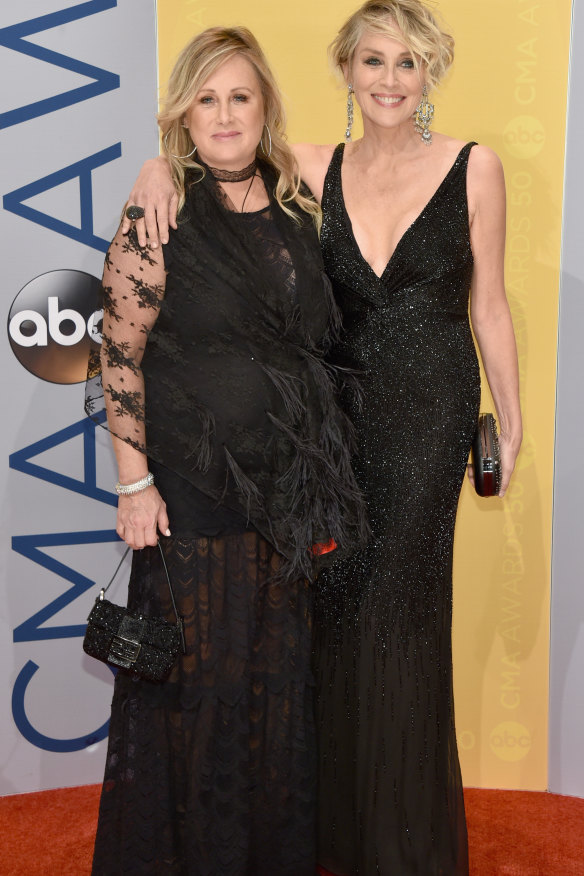
Stone with sister Kelly.Credit: Getty Images
When I say to Stone that this strikes me as the saddest and sickest part of all, she argues that her grandmother was another of Clarence’s victims: he bashed her up constantly, just as he had beaten their daughter, Stone’s and Kelly’s mother Dorothy.
“The last time my mother saw my grandfather, two weeks before he died, my grandmother’s face was black and blue and she had choke marks around her neck,” Stone says.
Clarence’s demise was a release for both Kelly, then 11, and Stone, 14. At the funeral, Stone went up to the open coffin and poked the body to make sure he was dead. For a long time afterward, the abuse was not discussed, even between the sisters. Stone, who confided only in fellow members of an incest survivors’ group, writes: “We all, in our family, had kept secrets of shame and terror.” The joint decision to bring the truth into the open has been liberating, she says. She hopes that writing about it will help other families find the courage to confront crimes that, left hidden, damage one
generation after another. “We have to break this chain of abuse. It’s not going to stop without some transparency and some education.”
Stone hints in the memoir that the psychological scars left by Clarence have affected her capacity for intimacy. This gives new relevance to what she said in a Playboy magazine interview soon after Basic Instinct came out. Asked whether it felt odd to simulate sex for an audience of millions, she replied, “I suppose I reveal some sort of disturbed part of my personality when I tell you that I’m more comfortable in that situation than in a real intimate situation.” She was soon to be MC at a concert at a US military base, whooping it up with thousands of marines. “I know exactly how to have that relationship,” she said. “That’s easier for me than being alone with one man in my living room.”
Such was the hullabaloo over Basic Instinct that, for a while, Stone was mobbed wherever she went. “There were people outside your house, people jumping all over your car, people chasing you down the street,” she says. Amid the mayhem, she made her next film, Sliver. Its Australian director, Phillip Noyce, remembers that Stone would take hours to come out of her trailer. When she emerged, he found it difficult to communicate with her.
She had put in a sizzling performance as Catherine Tramell, but it seemed all anyone could talk about was the view up her skirt.
“Sharon was under enormous pressure,” he tells me by email. “I’m not sure she completely believed it was her talent alone that had overnight catapulted her into [being] the most sought-after actress in the world.” Yes, she had put in a sizzling performance as Catherine Tramell, but it seemed all anyone could talk about was the view up her skirt. Says Noyce: “The baggage from that one shot during the interrogation scene was overwhelming. On all of us.”
Another Australian, Bruce Beresford, directed Stone in the 1996 movie Last Dance, in which she played a double murderer on death row. “The film was a disaster,” says Beresford, but working with Stone was a treat. “I’d heard stories about her being difficult but it wasn’t my experience. She was always very cordial and straightforward. She didn’t have any film star affectations that I could see.” Stone’s technical skill astonished Beresford. Not only
could she cry on command, she could, if required, produce a tear in one eye only – either the left or the right – and make it roll down her cheek, right on cue, in take after take.
She won a Golden Globe award for Casino in 1996 and was nominated in 1999 and 2000 for her films The Mighty and The Muse. But it seems to Beresford that Stone has never received quite the level of professional respect she deserves. He attributes this to the lasting effect of the interrogation scene. “I think perhaps that when she did that, she became a bit of a laughing
stock,” he says. “Somehow it demeaned her.” Given her beauty and ability, she could have been expected to have a huge career. But it was always sort of second-rate after that.”
“Abusers are a dime a dozen. And everyone knows who they are. It doesn’t require a list of names from me.”
When Basic Instinct was released, Stone was 34 – middle-aged in actor years. She assured GQ magazine she’d do whatever it took to maintain her youthful appearance: “If I have to sleep upside down like a bat so I don’t look like a basset hound, that’s what I’m gonna do.” By 1997, at 39, she was pointing out in The New York Times that male actors were held to be in their prime at the same age their female peers were regarded as over the hill: “When they call me up and they tell me that I’m too old to work opposite Mel Gibson in Conspiracy Theory, I want to walk over to the studio and blow somebody’s brains out.”
In the spirit of the #MeToo movement, Stone suggests in her book that she might identify the Hollywood honchos who over the years have sexually harassed her – “threatened to fire me if I didn’t put out, for example”. She writes: “I suggested recently that if they would only sit with me and talk it out, I would let it go, without revealing their offensive behaviour. But so far, not one of them has manned up.” Asked if she intends to act on her warning, she is oddly dismissive: “Abusers, frankly, are a dime a dozen. And everyone knows who they are. It doesn’t require a list of names from me.”
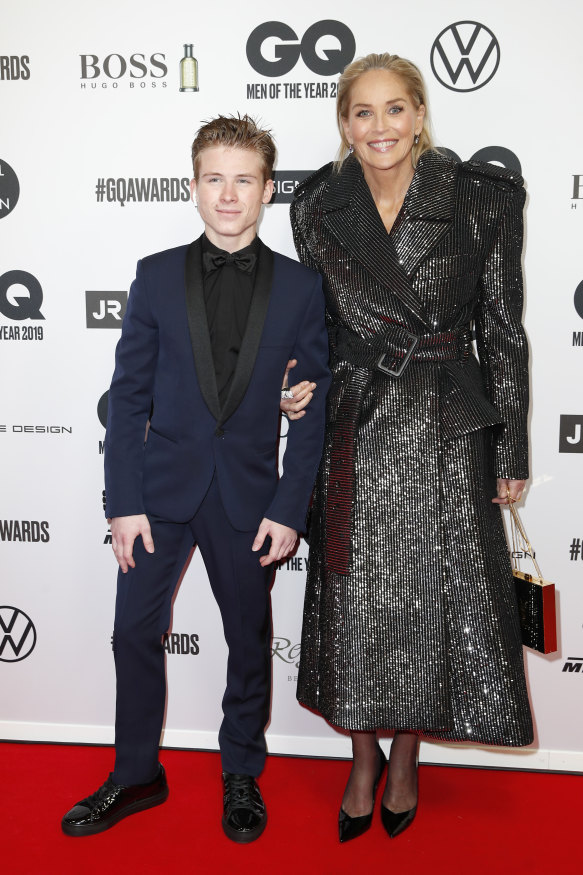
Stone with son Roan, the subject of a custody battle when younger.Credit: Getty Images
At just 43, Stone was felled by a stroke. It was caused by a ruptured vertebral
artery and, by her account, she was given only a slender chance of survival. In the intensive care ward, she lost a fifth of her body weight. “I came out of the hospital looking like teeth on a stick,” she says, with her usual colourful turn of phrase. Back at home, she realised she had memory loss when she didn’t recognise the gardener. She also had lingering difficulties with her balance, speech, vision and hearing. She reckons it took years to teach herself to read and write again.
While all this was happening, she was breaking up with her second husband. After a brief marriage to film producer Michael Greenburg in the mid-1980s, she wed San Francisco newspaper executive Phil Bronstein in 1998. Two
years later, they adopted a baby boy, Roan, and in 2004 they divorced. Roan initially spent three weeks at a time with each parent, travelling between
San Francisco and Stone’s home in Los Angeles.
When Roan reached school age, Bronstein was awarded primary custody during the school term, triggering a drawn-out legal fight. Press reports of the case weren’t always flattering to Stone. In 2008, a judge contrasting the parenting styles of the opposing parties noted that the actor had advocated Botox injections to fix Roan’s problem with foot odour, while Bronstein had suggested the boy use foot deodorant and wear socks with his shoes.
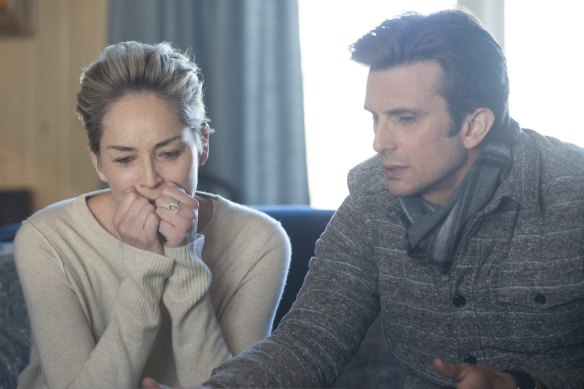
In the 2017-18 miniseries Mosaic.
Stone is delighted to have ended up having Roan – and the two sons she
subsequently adopted – under her roof, but says lawyers’ fees and the loss
of income while she was recovering from the stroke left her in a large
financial hole. “I lost everything,” she says. “All the money out of my bank
account, everything I had, was gone.”
“You don’t like her? She’s difficult? You’re sick of her? Great. Throw her in the trash. I don’t care. I’m done with her too.”
She remortgaged the chateau and returned to work. Basic Instinct 2, an ill-advised attempt to cash in on the success of the original, met with howls of derision in 2006. Four years later, Stone was reduced to taking a guest role in the 11th season of Law & Order: SVU. Soldiering on, in 2015 she landed her own TV series, Agent X, in which she played the US vice-president. It was axed after one season, but at least she was back in the game. At 57, she posed for US Harper’s Bazaar magazine wearing nothing but jewellery and a pair of
stilettos. “I’m aware that my ass looks like a bag of flapjacks,” she said, secure in the knowledge that her arse looked a million dollars.
Part way through our chat, which ends up being the promised 45 minutes, Stone announces that she no longer has an agent. “I’ve been let go,” she says. I am stunned. She’s been dropped? What reason was she given? “That I’m really hard to cast and there aren’t roles for people my age. And, of course, I’m somewhat difficult.”
I protest that if anything her career seems to be in resurgence: she got good reviews for her roles in HBO’s Mosaic, the 2018 romantic comedy All I Wish and the 2020 series Ratched. Stone allows that she is likely to pick up another agent. But who knows? “Maybe I won’t. Maybe this is it.”
In a way, she wouldn’t mind. Writing the book has changed her, she says. It’s as if letting go of the family secrets has relieved her of the need to wear a mask. “I really very much enjoyed being Sharon Stone. It was a great front. But I am enjoying being myself more.” Warming to the theme, she says her former agent may have been right to cross “Sharon Stone, actress” off the books. “You don’t like her? She’s difficult? You’re sick of her? Great. Throw her in the trash. I don’t care. I’m done with her too.”
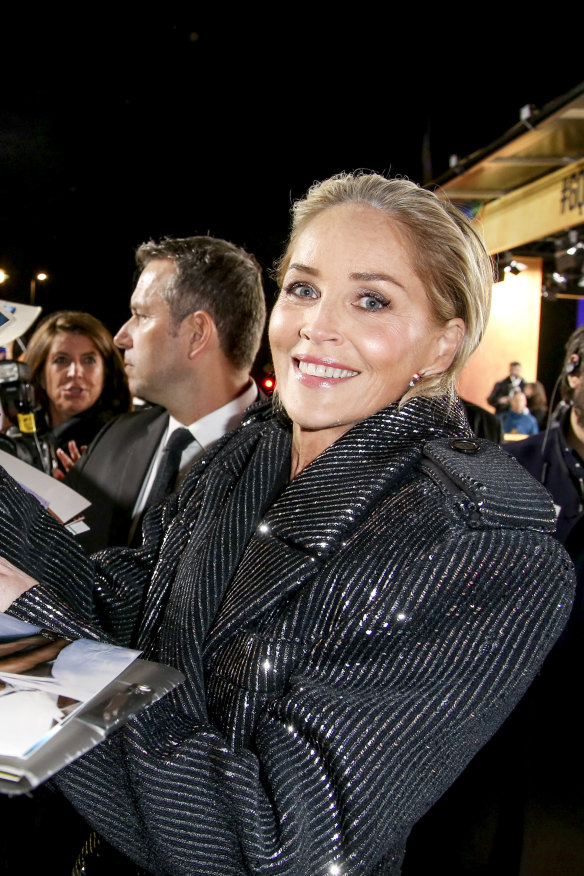
On picking up another agent: “Maybe I won’t. Maybe this is it.”Credit: Getty Images
Rupert Everett has written that early in the rehearsal period for A Different Loyalty, he realised something about Stone that had hitherto escaped him: “She was utterly unhinged.” He adored her, but there was no escaping it, “This girl was stark raving mad.” Stone herself acknowledges her eccentricity. “I do easily accept that I could be seen as a quirky broad,” she writes in The Beauty of Living Twice (which, when you think about it, is a pretty nutty title).
The journalist John Lahr found her tiresome and manipulative. Years after his piece in The New Yorker, he said that of all the people he had profiled in his distinguished career, he had really disliked only one: “That was Sharon Stone.”
But it seems to me there is much to admire. The fact that she has helped raise large sums of money to build schools in Africa, for instance, and so many millions for research to find a cure for AIDS that in 2013 she received the Peace Summit Award, bestowed each year by the Nobel peace laureates. The fact that when her family was devastated by COVID-19 last year – her sister Kelly and brother-in-law were hospitalised, her grandmother and godmother died – she recorded a raw and angry video in which she blamed then president Donald Trump for her country’s wholly inadequate response to the pandemic and urged people not to vote for “a killer” at the next election.
The fact that she is still looking for romance and, judging from photos in the gossip magazines, prefers her men to be Argentinean models or Italian real estate moguls two or three decades her junior. The fact that she signed up to the dating site Bumble, and when her profile was removed after other users reported it as a fake, tweeted, Hey @bumble, is being me exclusionary? Don’t shut me out of the hive.
I like her bravado. Her intensity. Her insouciance. Her sheer Sharon-F…ing-Stone-ness.
To read more from Good Weekend magazine, visit our page at The Sydney Morning Herald, The Age and Brisbane Times.